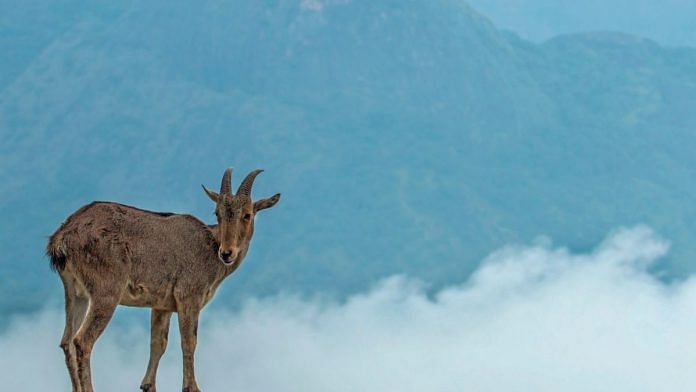Chennai: The Tamil Nadu government’s first-of-its-kind mission to save the state animal, the endangered Nilgiri Tahr, has gathered pace with the conclusion of a survey that took note of its population and behaviour.
The survey which ended on 1 May is part of the five-year “Project Nilgiri Tahr” launched in 2022 to safeguard the animal that finds mention in South India’s ancient Sangam literature. It is aimed to understand the population of these sure-footed ungulates, their distribution areas, and behaviour. The survey was done a month after a saddleback Nilgiri Tahr was radio-collared on 21 March.
The initiative also aims to conserve the species through multiple components, conducting a bi-annual synchronised survey to estimate the species’ population, radio-collaring to understand its movement pattern, and re-introducing the species to its historical habitats.
There will also be diagnosis and treatment for lump disease, the ungulates’ grassland restoration in the upper Bhavani, and implementation of eco-tourism, and community outreach involving indigenous communities living close to the Nilgiri Tahr habitat.
The initiative, earmarked at a budget of Rs 25.14 crore, is being implemented by partnering with institutions such as the Wildlife Institute of India, the World Wide Fund, Tamil Nadu Veterinary and Animal Sciences University (TANUVAS), and the International Union for Conservation of Nature (IUCN). The IUCN has categorised the Nilgiri Tahr as an endangered species.
While there have been multiple efforts in India to reintroduce a species as part of conservation efforts – including the Cheetah Reintroduction Project (Project Cheetah) in the Kuno National Park and the reintroduction of tigers in the Sariska Tiger Reserve (STR) in Rajasthan – none of the projects envisaged as many objectives as ‘Project Nilgiri Tahr.
“The initiative is not just aimed at conserving the species. But also reviving its habitat and the ecosystem,” said scientist Paul Peter Predit of the WWF.
Supriya Sahu, Additional Chief Secretary, in the Department of Environment, Climate Change, and Forests, told ThePrint that this was the right time to implement a project like this. “It is categorised as an endangered species by the IUCN. We do not want to start such an initiative when it is extremely difficult to find the species,” she added.
Project director M.G. Ganesan said the administrative team has seven members including himself, an assistant director, a research coordinator and four senior research fellows (SRFs), who coordinate works from the ground and are based in four tiger reserves in the state namely, Anamalai Tiger Reserve, Srivilliputhur Meghamalai Tiger Reserve, Mudumalai Tiger Reserve, and Kalakad Mundanthurai Tiger Reserve. The office of the project director is in Coimbatore.
Also read: Environmentalists petition US govt seeking endangered species protection for horseshoe crab
Reintroduction of the species
Endemic to the Western Ghats in Tamil Nadu and Kerala, the population of the Nilgiri Tahr was estimated at 3,122 by the WWF-India in 2015. Once found in the entire stretch of the Western Ghats, it is now seen in fragmented pockets with the existing population also under severe stress due to habitat loss. The species inhabits grassland habitats at elevations from 1200 to 2600 m.
One of the key components of the project is the reintroduction of the animal in its traditional habitat where it has recently gone extinct.
According to Predit, after finding potential habitats, the team will look into the causes of the extinction followed by a habitat suitability-study. The habitat will also be compared with the existing habitat to assess if the selected one was conducive to the species’ survival.
Predit said the selected habitat should have some connection with the metapopulation so that a continuity of population is established in future. One such place identified by the team is Glenmorgan in the Nilgiris, which is three hours away from the Mudumalai Tiger Reserve.
“So, in the long run, we have a population that is connected. Proper gene flow will be happening,” Predit said. He added that grassland restoration would be crucial in this as the habitat should be able to hold the population to avoid human-animal conflict in the future.
According to IUCN, species reintroduction is the deliberate translocation of living organisms from one place to another for many objectives including conservation. The translocation of conservation can entail releasing the organism within or outside the species’ indigenous range, the known or inferred distribution generated from historical (written or verbal) records, or physical evidence of the species’ occurrence.
However, the initiative also carries many risks and there should generally be strong evidence that the threats that caused any previous extinction have been correctly identified and removed or sufficiently reduced, states IUCN guidelines.
The team said it would monitor the translocated individuals to ensure their survival and natural breeding and subsequently expand it to other regions.
Ecotourism and challenges
The state is mulling ecotourism around the species’ habitat after the restoration and three locations – Coimbatore, Nilgiris, and Meghamalai – have been identified as the spots. Ganesan said tourism would not affect the natural living conditions of the species and community outreach would also be done through symposiums and workshops, also involving the indigenous communities in this habitat.
However, the work is not without its challenges. Ganesan said that covering a large landscape has its challenges and the team mostly ends up trekking to identify individual species as the Nilgiri Tahr is mostly found in cliffs in fragmented habitats. He said the shrinking grassland forest fires are also a great challenge for the survival of the species.
(Edited by Tikli Basu)
Also read: Indian zoos have a numbers problem. Too many animals, not enough vets, biologists, educators



